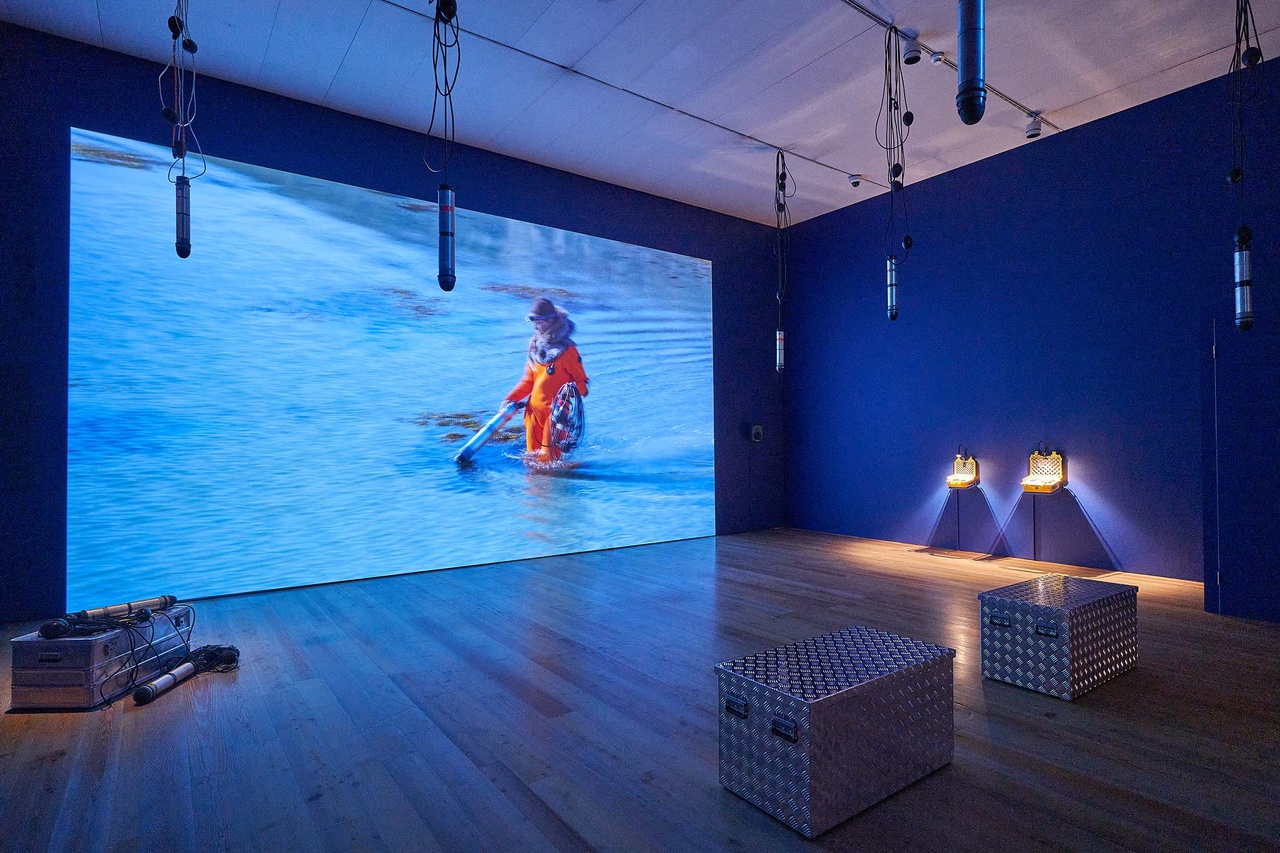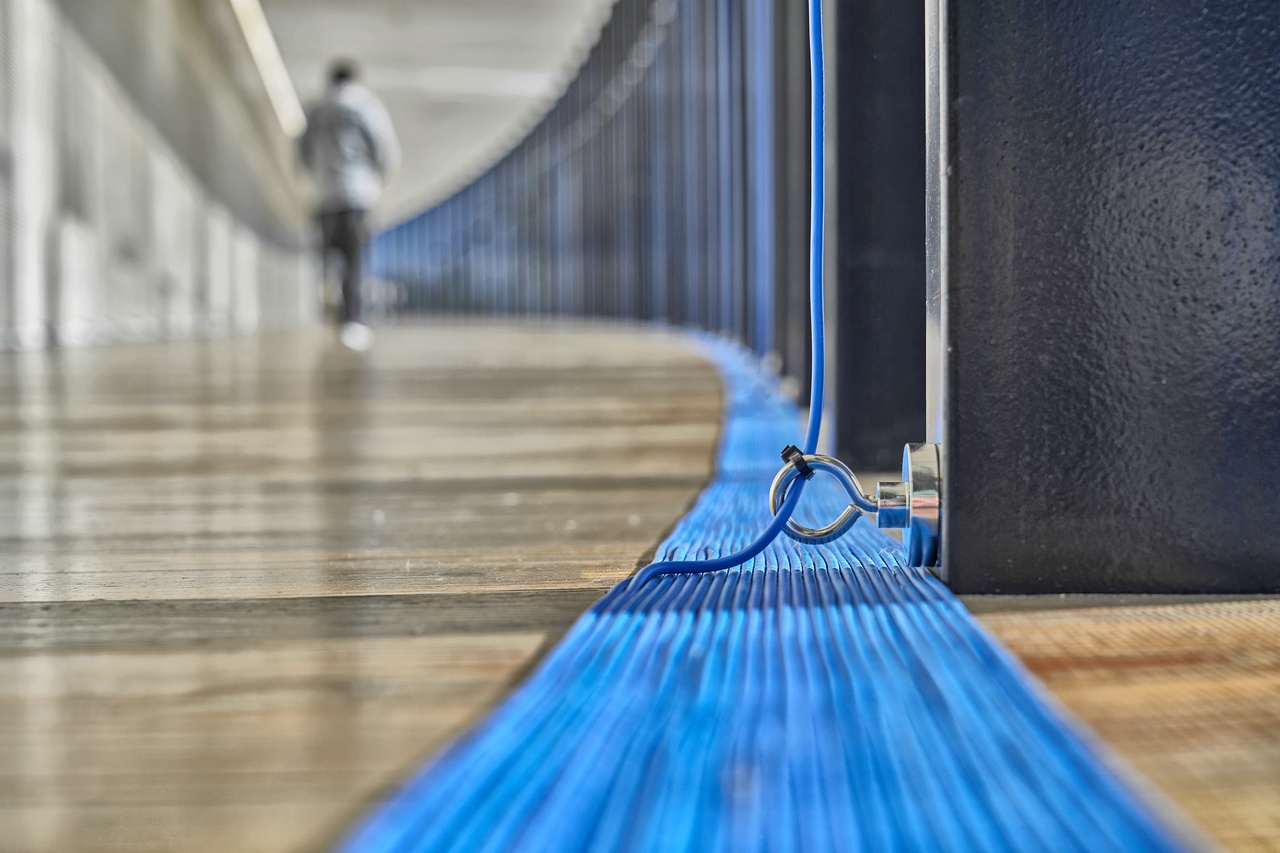SOUND OR SO Brit Barton on “À bruit secret: Hearing in Art” at Museum Tinguely, Basel

Ursula Biemann, “Acoustic Ocean,” 2018
Since 2015, Annja Müller-Alsbach, curator at Museum Tinguely in Basel, has been presenting a five-part series of exhibitions, each of which exploring one of the five basic human senses. This spring, the fourth and most recent iteration of the series, “À bruit secret: Hearing in Art,” was exhibited as an experimental group survey with work that spanned the Baroque, Avant-Garde, and contemporary moments. The museum – a mainstay of the city of Basel since 1996 – is billed as “a cultural commitment of Roche,” [1] and was built by the pharmaceutical company to house Swiss-born Jean Tinguely’s conservationally cumbersome, thunderous, and often mechanically driven Dada-esque works. Overlooking the Rhein from its prime location at the edge of Roche’s large campus within Solitude Park, Museum Tinguely is renowned for displaying a permanent collection of the artist’s kinetic and in many cases manually activable works, which are particularly well-suited for families and tourists alike. With that in mind, Müller-Alsbach’s exhibition series aiming to address the senses in a historical and contemporary art context aligns with Jean Tinguely’s noisy but sensorially pleasing showcase.
Spread across three floors, the wide-ranging survey was a comprehensive and at times loose display in breaking down or demonstrating the acts of listening and noise-making, as well as the ubiquity of audible encounters. Although each work stood under the broad category of hearing, there were works that felt more forced to align with the allegory while several other pieces transcended the concept, prodding us to consider what we take for granted when it comes to living with a sense that can conjure so much. Of all five exhibitions dedicated to the human senses, “À bruit secret” stands on possibly the shakiest and most reductive premise, but ultimately the curatorial concept explores how the five senses correspond and are subject to interpretation through the ever-changing state of art.
A broad array of analog and static works were represented, like the Marcel Duchamp readymade À bruit secret (With Hidden Noise, 1916/1964) that stands as the exhibition’s namesake but does little metaphoric lifting to expand on hearing as a sense. As the small sculpture, which rattles when shaken, contains an unknown object placed inside a ball of twine, originally added by art patron Walter Arensberg, it rather reinforces the Surrealist aspects of hearing and the mysteries within it.
The exhibition opened with the differing practices of artists Christina Kubisch, Meret Oppenheim, and Isa Genzken, which, despite their distinct eras of production, quickly established the erotic implications of our sense of hearing. Oppenheim’s bronze sculpture, Das Ohr von Giacometti (1959), depicts fellow Swiss Surrealist Alberto Giacometti’s ear as an ambiguous, otherworldly form that includes a clenched fist for an earlobe along with vine-like or floral suggestions for the curvatures of the helix and antihelix. The intimate scale of the sculpture, no bigger than the palm of a hand, and the playful allusion to the artist and anatomy, is a seductive visual. In close proximity to the mid-century work was Genzken’s Ohr (1980), a large photographic image of a woman’s nondescript ear. Both works were preceded in the exhibition by Christina Kubisch’s twelve-channel composition and participatory audio experience Il reno (2023), which played back underwater recordings of the Rhine in Basel through personal headphones that were handed out at the entrance. As one walked through the museum’s long and windowed corridor to the exhibition’s first room, audio sensors triggered different recordings with sonic variations of calm and more active moments beneath the water. A savant-style feat of technological installation, Il reno was an intriguing way to begin, reminding the visitor that what cannot be seen is still perceptible in some form or another. But from Oppenheim’s interpretation of what an ear could be, to Genzken’s absolute and unequivocal representation of what an ear actually is, the curatorial approach for “À bruit secret” became apparent: the exploration of the senses raises just as many philosophical questions relating to time and space as it does about materiality and sensorial interdependency.

Christina Kubisch, “Il reno” (detail), 2023
Following the initial examples, a selection of early- and mid-20th-century works highlighted sound as simultaneously serious minimal art and farce. A video featuring a performance of Kurt Schwitters’s Sonata in Urlauten (Sonata in Primordial Sounds, 1922–32) and a room-filling installation of Robert Rauschenberg’s Oracle (1962–65) were among the most notable exhibits of the entire survey. Schwitters’s Sonata is a significant expression of postwar Dadaist absurdity. Developed over ten years, the forty-minute piece created a symphonic structure of four movements, including a backward reading of the German alphabet at varying tempos three times. Rauschenberg’s Oracle, exhibited in Switzerland for the first time, stood as its own five-piece orchestra of found metal and was solemnly presented with distance and stanchions that occupied a whole gallery. Each part of the work, which includes a wash basin and running water, held concealed radios that broadcasted their white noise into the otherwise empty room.
The most lasting and poetic implications of “À bruit secret” were the connections drawn between the inevitable extinctions of animals, landscapes, and dialects and the critical necessity to document them as they are, with compelling visual and sonic installations: outside the museum or in the final exhibition rooms beneath the ground floor, artists James Webb, Kader Attia, Emeka Ogboh, and Ursula Biemann were displayed separately, yet with related themes of research and preservation. An in situ outdoor piece, Webb’s sound installation There’s No Place Called Home (2004–ongoing) has been realized in over 50 artistic contexts, including the 12th Havana Biennial (2015), before it was redone in the trees of Solitude Park in front of Museum Tinguely. Calls of tropical, non-native, and rare bird species were emitted from hidden speakers and subtly woven into the park’s acoustics, creating a liminal space of seemingly familiar and yet slightly different, thus uncanny, soundscape.
Attia’s work Mimesis as Resistance (2013) occupied the nominal entryway on the museum’s lower level with a video installation that consisted of edited fragments from David Attenborough’s BBC documentary The Life of Birds (1998). Attia’s video featured the superb lyrebird, which deceptively mimics the sounds of other species, as well as the sounds of camera shutters, power saws, and car alarms. After an exhibition of somewhat forced mechanical or musical sound environments, watching and listening to the Australian-native species mock synthetic sound pollution was a strange but clever and welcome moment of respite.
Following Attia’s antechamber was a sequence of rooms, each one a drastic atmospheric departure from what came before. Ursula Biemann’s research-based practice was presented through her video installation Acoustic Ocean (2018). In a blue room that mimicked the sensation of being in a submarine, a large video projection featured a fictional Indigenous field researcher – played by the Swedish Sami singer, actress, and climate activist Sofia Jannok – as the lone protagonist attempting to record the inaudible creatures of the Norwegian Lofoten Islands using a series of antiquated audio devices, such as a hydrophone and parabolic microphone. Blending fact and fiction, Biemann’s work draws from archival footage and self-created documentation. Though less on point as an audio experience, it created an interesting tension with the trickery between what we hear and what we imagine to hear.
Emeka Ogboh dispensed with the moving image in favor of a purely sonic tour via an immersive and intense soundscape emanating from a parked yellow Volkswagen Danfo bus. LOS–CDG (Lagos to Paris) (2019) consisted of brash city sounds that were carried outside the gallery through four loudspeakers, while a 45-minute piece could be intimately listened to with headphones while sitting inside the bus. Various African languages that included pidgin, Yoruba, and Igbo were obviously unknown to the vast majority of a Basel audience. However, collaged with electronic music and hectic traffic sounds, Ogboh’s installation created a layered and diverse experience ready to transcend linguistic and cultural barriers.
The most nuanced of artworks in “À bruit secret” was contributed by the Turkish artist and musician Cevdet Erek and served as a finale and conclusion to the exhibition. As part of Shore Scene Soundtrack (2006–ongoing), a rectangular piece of synthetic carpet vaguely reminiscent of Kazimir Malevich’s Black Square (1915) hung in the last room of the museum’s lower level. Accompanying the wall piece was an artist’s book that served as an instructional guide demonstrating how to move your hands across the carpet to imitate the sound of the ocean. Through circular movements or varying pressure, the spectrum of sounds created – crashing waves or the dull roar of an incoming tide, for example – was perplexing in just how devastating and mystifying something so simple and banal can be. The haptic core of Shore Scene Soundtrack was affecting and thus embodied the fact that sensations, like art, are ultimately subjective and difficult to categorize.
To try to isolate any sense is an absolute fallacy when it comes to experiencing an artwork or art exhibition, but I concede that perhaps the point of “À bruit secret” was just that. Which begs the question of whether any individual sense other than sight could carry an entire survey or show. Consequently, the antiquated conundrum of hierarchizing the senses inevitably comes to the fore: the last sense to be explored, via the forthcoming finale of this exhibition series, is sight.
“À bruit secret: Hearing in Art,” Museum Tinguely, Basel, February 22–May 14, 2023.
Brit Barton is an artist and writer based in Zurich and Chicago.
Image credit 1. © Ursula Biemann / Museum Tinguely; photos Daniel Spehr; 2. © Museum Tinguely, Basel;
For legal reasons, some images that accompanied this text at the time of publication can no longer be shown.
Notes
| [1] | See the sponsorship information on the museum website. |
